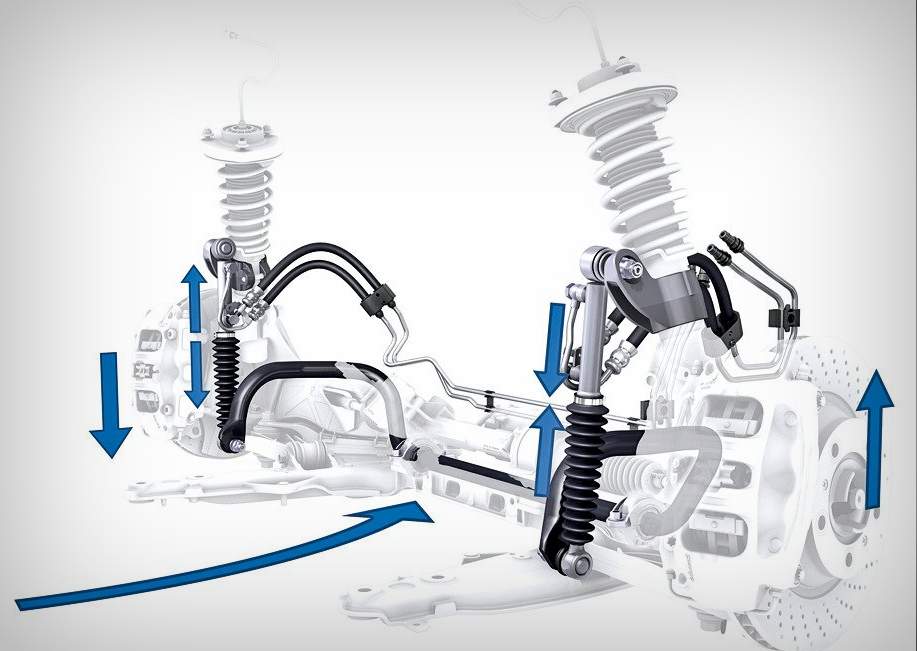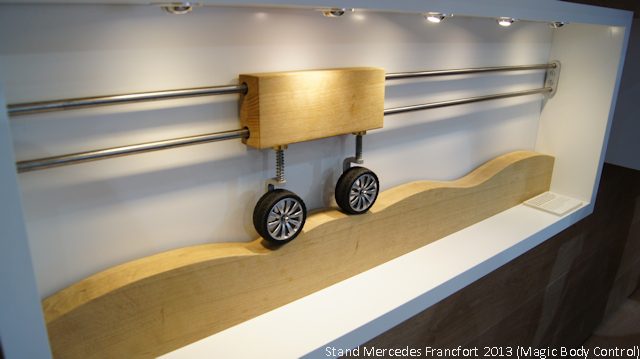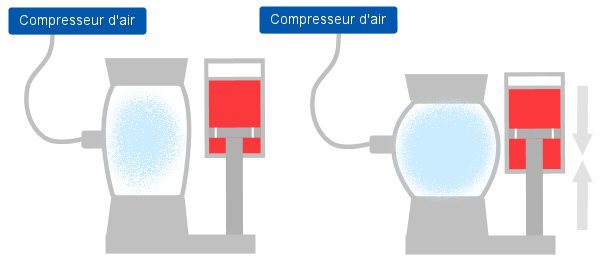
Active and semi-active suspension: work
Content


More and more on high-end models (and less and less on Citroëns ...) active and semi-active suspensions seek to increase comfort (especially for active ones) and change the suspension calibration upon request. So let's take a look at the main existing technologies.
See also: the work of the "classic" suspension.
Little reminders
Gas can be compressed, but liquid cannot be compressed (except for extreme pressure, because everything is compressed ... Even a diamond. A neutron star), so one cannot hope to get a suspension based only on liquid.
The suspension consists of a shock absorber (piston) and a spring, which in the case of air suspension can be replaced with an airbag. The spring (or cushion) takes care of the suspension of the car in the air, while the shock absorber (piston) controls the velocity deflection (therefore prevents the spring from bouncing when required, but it also allows the suspension to be controlled.calibration to have stiffness or flexibility). Therefore, it reduces the speed of movement during compression and rebound, hence the name of the shock absorber.
Difference between active and semi-active suspension
In case of suspension activeThe suspension stiffness can be changed, but we can also adjust the ride height. Thus, the suspension can prevent roll in a corner, but it can also raise the level if you overload the car (avoiding a rear that is too low, which improves balance and therefore safety). In short, the orientation (by the electronics) is perfect!
In case of suspension semi-active, only the damper setting can be changed.
In both cases, the suspension is controlled by an electronic computer that will control the opening or cutting of certain areas of the system, or even affect the hydraulic fluid level. A computer needs information from various sensors to function (they are similar to its eyes), such as steering wheel angle, vehicle speed, suspension travel, etc. In short, all physical variables useful for changing suspension settings. ... If one of the sensors no longer works, the computer no longer has information for the suspension to work properly (it cannot work blindly).
Hydropneumatic suspension (active suspension)
This system includes a hydraulic circuit, but the damping is done with gas: nitrogen. It was Citroën who invented this process on the legendary DS. Since then, the system has improved, but the principle has remained the same.
Please note that the layout can be other, this is a summary illustration. The spheres may not be one with the hydraulic damping, knowing that others are placed in the chain to be able to adjust the suspension stiffness (sport mode).
1 : it is a flexible membrane that separates liquid from air (more precisely, from nitrogen).
2 : This is the top of the sphere where nitrogen is under pressure. It is he who replaces the spring of a conventional shock absorber.
3 : the lower part is an almost classic shock absorber piston, its role is to limit the driving speed and therefore to bounce the car on bumps.
Operation details
When we load the car, the suspension is crushed (in our case, compressed air). The hydraulic pump can then direct the fluid to raise the trim (ground clearance) of the vehicle so that the rear is not too lowered.
In addition, for comfort mode and sport mode to exist, additional spheres connected to the chain are needed (which is one per wheel plus the others connected to the chain). When we want more harshness, we condemn certain areas. In fact, the more spheres are connected to the loop, the more gas is available for damping and therefore flexibility. In the latest version of Hydractive III, there are only 7 of them.
Pros and cons
+ Exceptional comfort due to gas suspension and, above all, electronic position control (the vehicle always remains horizontal). The Xantia Activa was quite revolutionary as it became flat in the corners (remember the ad for the latter with Carl Lewis).
+ Comfort even in sport mode, suspension stiffness only occurs when necessary (this change can be made several times per second ...). In a word, oil and oil money!
+ The ability to adjust the ride height (which means it remains constant, despite the weight on board)
+ Several driving modes (comfort and sport)
+ Increased behavior by reducing pitch and roll (in some cases, there is a dynamic anti-roll bar, electronically controlled)
+ Good resistance to time, because nitrogen does not wear out compared to springs
– Expensive and cumbersome system
– Expensive when it comes to maintenance (because the membrane and spheres eventually “well” break down over time (150 to 000 km according to some)
– On the old Hydractive, the system is connected to the power steering and brakes. In the end, when there is trouble, everything goes out of order! European standards have since banned this process.
Example: Citroën Hydractive.
Note that while the C5 has hydropneumatic suspension, the C4 Picasso 1 has air suspension (technology below).
Air suspension (active suspension)
This system is very similar to hydropneumatic, but is content with only air.
Also read: in detail how the air suspension works.

Here, the example uses the rear suspension arrangement of the C4 Picasso again, the shock absorber is located next to the airbags (they are integrated into the Mercedes Airmatic body, but the principle does not change). This is not the same on the front axle where there is little space.

Please note that in some cases pillows can work with controlled impacts. Here these are simple shock absorbers, the calibration of which does not change.
The pillow cushions impacts and suspends the car, while the shock absorber (piston) limits the rebound effect, helping to keep the road (it controls the speed). Note that this rear arrangement also exists for conventional suspensions, so the spring replaces the airbag (we are usually used to seeing them as a single unit, the spring surrounding the piston). Also take into account that there are other devices other than the diagram above, as seen on the lower Mercedes.
Here again air is used, which absorbs shocks, but unlike hydropneumatics, air is injected or removed instead of liquid. Thus, we can also change the setting (stiffness) of the suspension, as well as their height (ground clearance).
The quality and disadvantages are about the same as those of hydropneumatics.
Example: Mercedes Airmatic.

Magic Body Control (Mercedes) with Airmatic air suspension
Note that Mercedes has put forward a "vice" (in the S-Class) for the road to be analyzed by cameras. When the computer detects bumps, it softens the suspension in a split second ... It's called Magic Body Control.
Suspension floor active (controlled damping)
It is sufficient to mechanically adjust the valve flow in the piston to increase the damping. This type of valve is then electronically controlled, after which several damping adjustments can be made according to the position of these valves. The faster they pass liquid from one compartment to another, the softer the suspension (and vice versa). Then we can get comfortable or sport mode. Note that this is the most economical way to obtain a semi-active suspension and that this principle is only used in the Golf 7 DCC.
It is about controlling only the shock absorbers and not the suspension springs as in the air suspension. In addition, the active air suspension can also have controlled damping. This is the case with Airmatic: airbags take care of the suspension, and adjustable dampers take care of damping (so they can change in terms of sizing, because they are adjustable).
Theoretical diagram
The computer controls the solenoids differently to influence the calibration. The more easily they allow oil to pass through, the more flexible the damping, and vice versa ... There are several ways to do this, especially with the help of magnetism (Audi Magnetic Ride). In addition, the location shown in the diagram can be completely different in practice.
1: The little blue stripes are valves to allow fluid to flow up and down (when the slurry is running). On classic pendants, they always work the same way. Here they are controlled by electronics, which allows you to change the possible flow, creating a more or less flexible suspension. Please note that here it is not the gas (air suspension) that takes care of the suspension at all, but the spring, everything is more classic.
+ Several driving modes (comfort and sport)
+ Increased behavior by decreasing the pitch
+ Less expensive and heavier than active suspensions
– Not active
- No ability to adjust ride height
– Lower comfort than on a tire (a spring will always be worse than an air cushion). Attitudes can't be fixed that well.
Example: Audi Magnetic Ride
Electromagnetic suspension (active suspension)
Here is an electromagnet that controls the suspension in the same way as in an audio speaker. I remind you that an electromagnet is a magnet powered by electricity, so we can change the strength of the magnet by adjusting the strength of the current. Knowing that magnets can repel each other, just use this setting to use it as a pendant. Bose invented it, and its use is still very rare.
All comments and reactions
Dernier comment posted:
katarate33 (Date: 2019, 06:15:14)
I still don’t understand how, thanks to all these great discoveries, xantia activa (hydrativa II) from 1999 still holds the moose passing record reading your benchmarking analysis. I'm going to tell you just so you understand that there is currently no better damping technology than Citroën's invention of 1950, that 1999 speed record that is still valid today. , most importantly, the efficiency of road holding.
Il I. 4 reaction (s) to this comment:
- Administrator SITE ADMINISTRATOR (2019-06-16 15:31:28): "Passage of the impulse", so to speak? Are you talking about evasion maneuver?
In this case, what speed is achieved?
I still doubt she still has the record.
- Etienne (2019-09-19 22:20:00): This is an impulse test well known since the first Mercedes A-Class was on its back in time. Xantia continues to hold the record ahead of porsche gt3 and others. A vulgar sedan with tires designed primarily to be low on fuel ...
- Katarate33 (2019-09-20 09:30:54): Well yes, mister administrator, the last ones who tried to break this record were Audi R8 v10 and Mclaren 675 lt in 2017. So, 20 years later, there is no photo. The record is still held, and in the specialized press not a word has been said about this, that is the question. Hydropneumatics had just been left to die of general indifference. I still cry for my Dsuper 5 and I just purchased one of the latest exclusive C5s from December 2015.
- Katarate33 (2019-09-23 19:20:40): By the way, the Xantia travel speed is 85 km / h versus 83 km / h for the Audi R8 V10 plus 5,2 FSI quattro 610 and MLaren 675 LT, 82 km / h. H Porche 997 GT3 RS Porche 996 GT2 Pocket 997 carrera 4S Mercedes AMT GT S
(Your post will be visible under the comment after verification)
Write a comment
Using the electrical formula E, you will find that:

